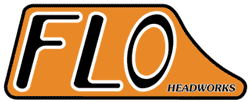|
Home
Twin
Cam Tech Tip Download
Tech Tip Articles
Fun to Ride Guide
Custom Engine Estimate
Custom Engine Building
Other
Products and Services
Perry's Bio
Friends
Catalog Request
Order
Links
| |

|
PAGE
1: FROM SOAPBOX DERBY TO THE NHRA CHAMPIONSHIP |
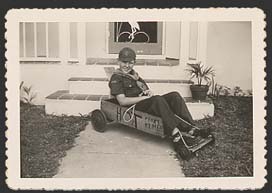 |
Even as
a little kid I had a natural instinct to build things with wheels and
make them go fast.
I
was born in Ohio and raised in Florida, where I built and raced soapbox
speedsters like the one to the left. |
|
In 1957 I bought my first
motorcycle. It was a ’52 Indian Warrior, a 500 c.c. vertical twin
with, shall we say, modest power. Even back then I was feeling the
“need for speed” and wanted my bike to be the fastest at school.
I
was studying auto mechanics then, and got myself transferred to machine
shop so I could go beyond sticking on parts and get right into the heart
of the motor, where performance tuning really comes from.
With
my developing skills in metal fabrication, I could make my Indian
unique. My first task was to port the heads for better airflow. Then I
added a bigger carburetor, valves and pistons. After some trial and
error, I achieved my goal: the fastest bike at North Miami High School.
More important, I knew at a very early age what I wanted to do with my
life.
|
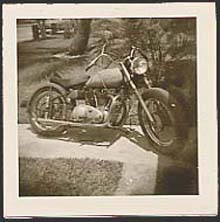
Perry's first bike,
a 1952 Indian Warrior |
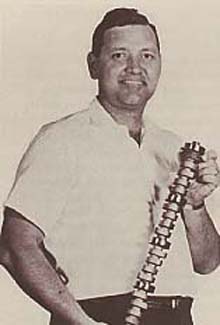
Harvey Crane,
"The Master"
|
Learning from the Master
In
1961 I went to work for Harvey Crane, whose name was a legend in racing
even back then. I was the fifth man in his small machine shop in
Hallandale, Florida — a lowly apprentice but aware of my extreme good
fortune in having the opportunity to learn directly from “the
Master.” I started out porting Chevrolet heads for competition. After
a few months my duties were expanded to valves, seats and final
assembly.
We
made those old Chevy valves very thin, with seat widths measuring only
.030 for intake and .045 for exhaust. I ground the height, width, and
cut the seat pockets by hand with a 70-degree cutter. My only guide for
this precision work was a hand-held mechanical pointed divider that I
adjusted by eye and feel. In that shop I developed the “tuner’s
instinct” for working with metal that has served me well for 30 years.
|
|
After
a little while Harvey trusted me to do all the heads for the dragsters
he sponsored. All were top-performance “rail” jobs. This was where I
learned the techniques for getting maximum power out of two-valve heads,
while maintaining reliability and—all-important in race
engines—managing heat buildup.
Building the motor that beat Don Garlits
Then
came the time with Pete Robinson from Atlanta. He was a drag racer who
had been using Harvey’s cams for years. This was my opportunity to
build heads for a world-class competitor in racing’s most extreme
engine tuning environment: Top Fuel.
Pete
was an advocate of titanium, and made a lot of parts out of this exotic
and hard-to-work-with metal for his Top Fuel dragster so it would be
lighter and stronger at the same time. (I should also mention that I
tested and matched all his valve springs myself because he was turning
this motor over at 10,000 rpm.)
In
our second year of collaboration, Pete beat Don Garlits for the world
Top Fuel championship. Pete held onto that trophy for three years, when
tragedy struck and he was killed in a crash.
After
five years in the high-stress world of drag racing, I was burned out and
ready for a change. I wanted to get back to my first love, motorcycles.
At that time the hotbed of American motorcycling was California.
|
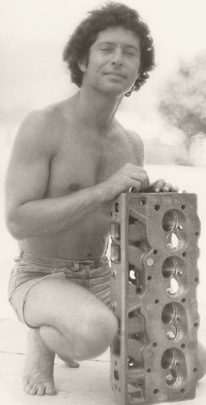
Perry with an early
project: a Chevy head from a drag racing "rail job".
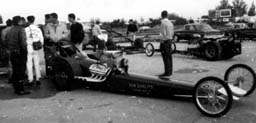
The car to beat: a
rare photo of "Big Daddy" Don Garlits' 1963 dragster.
|
|
CLICK ON PAGE 2:
L. A. DURING MOTORCYCLING'S GOLDEN AGE
|
|
